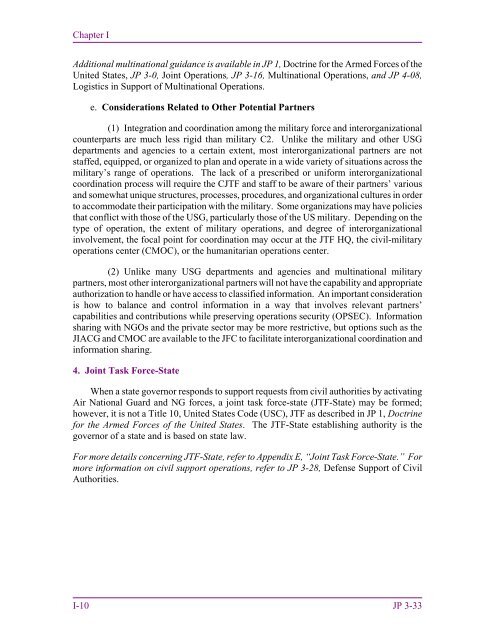JP 3-33, Joint Task Force Headquarters - Defense Innovation ...
JP 3-33, Joint Task Force Headquarters - Defense Innovation ...
JP 3-33, Joint Task Force Headquarters - Defense Innovation ...
You also want an ePaper? Increase the reach of your titles
YUMPU automatically turns print PDFs into web optimized ePapers that Google loves.
Chapter I<br />
Additional multinational guidance is available in <strong>JP</strong> 1, Doctrine for the Armed <strong>Force</strong>s of the<br />
United States, <strong>JP</strong> 3-0, <strong>Joint</strong> Operations, <strong>JP</strong> 3-16, Multinational Operations, and <strong>JP</strong> 4-08,<br />
Logistics in Support of Multinational Operations.<br />
e. Considerations Related to Other Potential Partners<br />
(1) Integration and coordination among the military force and interorganizational<br />
counterparts are much less rigid than military C2. Unlike the military and other USG<br />
departments and agencies to a certain extent, most interorganizational partners are not<br />
staffed, equipped, or organized to plan and operate in a wide variety of situations across the<br />
military’s range of operations. The lack of a prescribed or uniform interorganizational<br />
coordination process will require the CJTF and staff to be aware of their partners’ various<br />
and somewhat unique structures, processes, procedures, and organizational cultures in order<br />
to accommodate their participation with the military. Some organizations may have policies<br />
that conflict with those of the USG, particularly those of the US military. Depending on the<br />
type of operation, the extent of military operations, and degree of interorganizational<br />
involvement, the focal point for coordination may occur at the JTF HQ, the civil-military<br />
operations center (CMOC), or the humanitarian operations center.<br />
(2) Unlike many USG departments and agencies and multinational military<br />
partners, most other interorganizational partners will not have the capability and appropriate<br />
authorization to handle or have access to classified information. An important consideration<br />
is how to balance and control information in a way that involves relevant partners’<br />
capabilities and contributions while preserving operations security (OPSEC). Information<br />
sharing with NGOs and the private sector may be more restrictive, but options such as the<br />
JIACG and CMOC are available to the JFC to facilitate interorganizational coordination and<br />
information sharing.<br />
4. <strong>Joint</strong> <strong>Task</strong> <strong>Force</strong>-State<br />
When a state governor responds to support requests from civil authorities by activating<br />
Air National Guard and NG forces, a joint task force-state (JTF-State) may be formed;<br />
however, it is not a Title 10, United States Code (USC), JTF as described in <strong>JP</strong> 1, Doctrine<br />
for the Armed <strong>Force</strong>s of the United States. The JTF-State establishing authority is the<br />
governor of a state and is based on state law.<br />
For more details concerning JTF-State, refer to Appendix E, “<strong>Joint</strong> <strong>Task</strong> <strong>Force</strong>-State.” For<br />
more information on civil support operations, refer to <strong>JP</strong> 3-28, <strong>Defense</strong> Support of Civil<br />
Authorities.<br />
I-10 <strong>JP</strong> 3-<strong>33</strong>

















